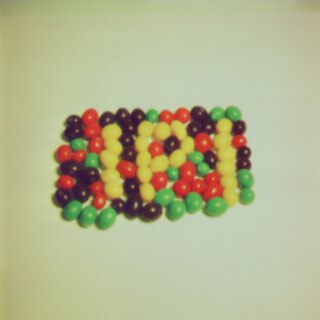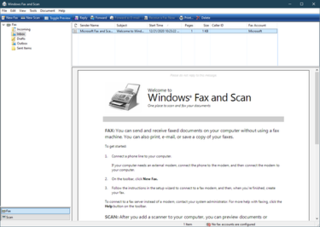
Electronic mail is a method of exchanging messages ("mail") between people using electronic devices. Invented by Ray Tomlinson, email first entered limited use in the 1960s and by the mid-1970s had taken the form now recognized as email. Email operates across computer networks, which today is primarily the Internet. Some early email systems required the author and the recipient to both be online at the same time, in common with instant messaging. Today's email systems are based on a store-and-forward model. Email servers accept, forward, deliver, and store messages. Neither the users nor their computers are required to be online simultaneously; they need to connect only briefly, typically to a mail server or a webmail interface for as long as it takes to send or receive messages.

Fax, sometimes called telecopying or telefax, is the telephonic transmission of scanned printed material, normally to a telephone number connected to a printer or other output device. The original document is scanned with a fax machine, which processes the contents as a single fixed graphic image, converting it into a bitmap, and then transmitting it through the telephone system in the form of audio-frequency tones. The receiving fax machine interprets the tones and reconstructs the image, printing a paper copy. Early systems used direct conversions of image darkness to audio tone in a continuous or analog manner. Since the 1980s, most machines modulate the transmitted audio frequencies using a digital representation of the page which is compressed to quickly transmit areas which are all-white or all-black.
Tagged Image File Format, abbreviated TIFF or TIF, is a computer file format for storing raster graphics images, popular among graphic artists, the publishing industry, and photographers. TIFF is widely supported by scanning, faxing, word processing, optical character recognition, image manipulation, desktop publishing, and page-layout applications. The format was created by Aldus Corporation for use in desktop publishing. It published the latest version 6.0 in 1992, subsequently updated with an Adobe Systems copyright after the latter acquired Aldus in 1994. Several Aldus or Adobe technical notes have been published with minor extensions to the format, and several specifications have been based on TIFF 6.0, including TIFF/EP, TIFF/IT, TIFF-F and TIFF-FX.
CUPS is a modular printing system for Unix-like computer operating systems which allows a computer to act as a print server. A computer running CUPS is a host that can accept print jobs from client computers, process them, and send them to the appropriate printer.
In information technology, header refers to supplemental data placed at the beginning of a block of data being stored or transmitted. In data transmission, the data following the header are sometimes called the payload or body.
A digital image is a numeric representation, normally binary, of a two-dimensional image. Depending on whether the image resolution is fixed, it may be of vector or raster type. By itself, the term "digital image" usually refers to raster images or bitmapped images.
JBIG is an early lossless image compression standard from the Joint Bi-level Image Experts Group, standardized as ISO/IEC standard 11544 and as ITU-T recommendation T.82 in March 1993. It is widely implemented in fax machines. Now that the newer bi-level image compression standard JBIG2 has been released, JBIG is also known as JBIG1. JBIG was designed for compression of binary images, particularly for faxes, but can also be used on other images. In most situations JBIG offers between a 20% and 50% increase in compression efficiency over the Fax Group 4 standard, and in some situations, it offers a 30-fold improvement.
A fax server is a system installed in a local area network (LAN) server that allows computer users whose computers are attached to the LAN to send and receive fax messages.

Windows Photo Viewer is an image viewer included with the Windows NT family of operating systems. It was first included with Windows XP and Windows Server 2003 under its former name. It was temporarily replaced with Windows Photo Gallery in Windows Vista, but has been reinstated in Windows 7. This program succeeds Imaging for Windows. In Windows 10, it is deprecated in favor of a Universal Windows Platform app called Photos, although it can be brought back with a registry tweak.

A standard test image is a digital image file used across different institutions to test image processing and image compression algorithms. By using the same standard test images, different labs are able to compare results, both visually and quantitatively.
Windows XP introduced many features not found in previous versions of Windows.
j2 Global, Inc. is an American publicly traded technology company based in Los Angeles, California. The company provides Internet services through two divisions: Business Cloud Services and Digital Media.

In computing a virtual printer is a simulated device whose user interface and API resemble that of a printer driver, but which is not connected with a physical computer printer.
Windows Messaging, initially called Microsoft Exchange Client, is an email client that was included with Windows 95, 98 and Windows NT 4.0.

Windows Fax and Scan is an integrated faxing and scanning application included in some versions of the Windows Vista operating system and all versions of Windows 7, Windows 8 and Windows 10. Windows XP includes Fax Console instead. The software is not compatible with T.38 technology and cannot be used for internet faxes.

A fax modem enables a computer to transmit and receive documents as faxes on a telephone line. A fax modem is like a data modem but is designed to transmit and receive documents to and from a fax machine or another fax modem. Some, but not all, fax modems do double duty as data modems. As with other modems, fax modems can be internal or external. Internal fax modems are often called fax boards.
Biscom, Inc. is a privately held enterprise software company with headquarters in Chelmsford, MA, and with a satellite office in Taipei City, Taiwan. Biscom’s primary focus is developing fax server solutions that facilitate inbound and outbound electronic fax communications. Biscom also develops managed file transfer and data conversion solutions.
CCITT Group 4 compression, also referred to as G4 or Modified Modified READ (MMR), is a lossless method of image compression used in Group 4 fax machines defined in the ITU-T T.6 fax standard. It is only used for bitonal images. Group 4 compression is based on the Group 3 two-dimensional compression scheme (G3-2D), also known as Modified READ, which is in turn based on the Group 3 one-dimensional compression scheme (G3), also known as Modified Huffman coding. Group 4 compression is available in many proprietary image file formats as well as standardized formats such as TIFF, CALS, CIT and the PDF document format.
The Lotus International Character Set (LICS) is a proprietary single-byte character encoding introduced in 1985 by Lotus Development Corporation. It is based on the 1983 DEC Multinational Character Set (MCS) for VT220 terminals. As such, LICS is also similar to two other descendants of MCS, the ECMA-94 character set of 1985 and the ISO 8859-1 (Latin-1) character set of 1987.






